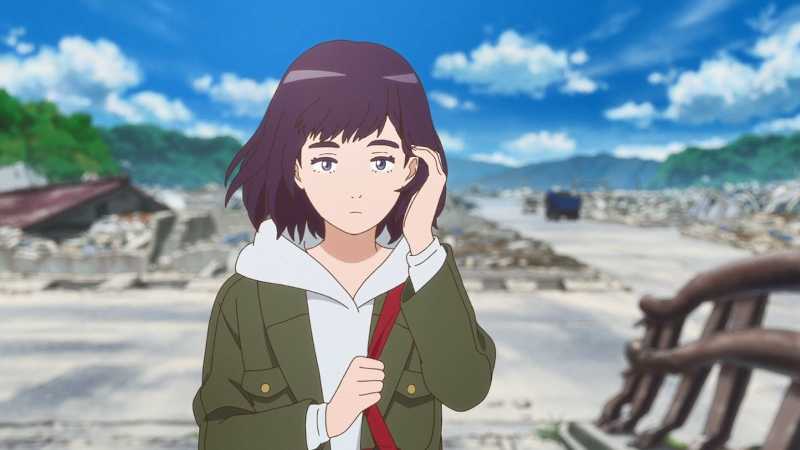Director – Shinya Kawatsura – 2021 – Japan – 100m
*****
Two children separated from their respective parents are taken in by an old woman in a benevolent, magical house with a malevolent monster nearby – plays in the Annecy Animation Festival 2022 which is taking place in a 100% on-site edition this year right now in the Official Competition section
A younger girl and an older girl find themselves at Kitsunezaki (Fox Cape) Bus Station that’s been wrecked in the 2011 Tohoku earthquake and tsunami. An old lady appears and takes them under her wing. They walk through forests, then up a hill, until eventually they arrive at a huge bungalow with a thatched roof which is to be the girls’ home. Kiwa, the old lady, claims to be their granny.
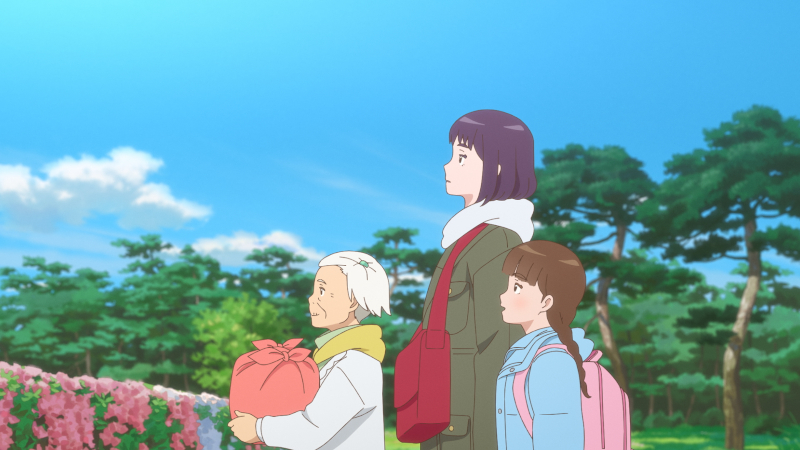
There’s something odd about the house, though. The older girl Yui accidentally makes a hole when she puts a finger through a paper wall. Later, the hole has mysteriously vanished. Then there are the drinks which appear out of nowhere when Yui says she’d like such and such a drink. At night, outside, strange turtle spirits (kappa) gather.
The younger girl Hiyori never speaks. This appears to be the result of some sort of trauma.
The old lady keeps the two girls busy. Cutting the grass, for instance. She reckons they need fresh air and a chance to take things easy. Yui however keeps thinking of the story of Hansel & Gretel after a copy of that book turns up. She worries about what terrible things the old lady might have in store for them.
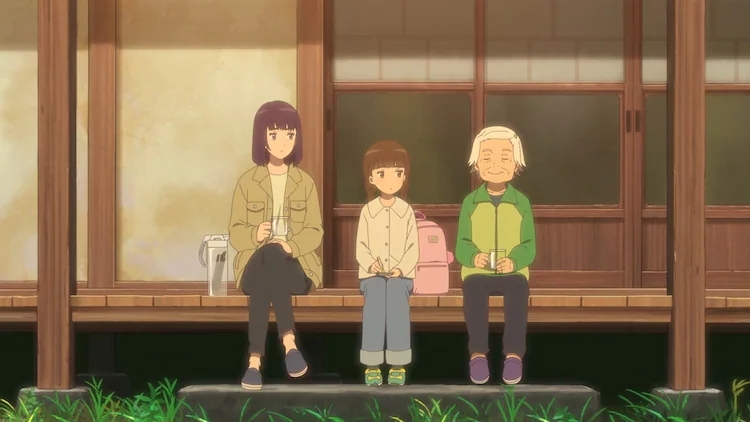
Fond of relating folk tales, the old lady tells the girls about a benevolent house that provides for its guests. This house, she explains, is a mayoiga – a house that offers hospitality.
After this, you’re half expecting the narrative to turn into a haunted house movie in which the apparently nice house turns out to be not so nice after all. That never happens, but the film does introduce a series of four caverns in the cove near the cliff below the house from which the trapped, hideous creature Red Eyes has somehow been released. Its appearance is presaged by that of small, worm or snake like creatures in the undergrowth near the house which likewise possess red eyes.
And when it finally turns up, a kaiju resembling nothing so much as a giant sea serpent, these little snake creatures peel off its surface. Also on the side of this force of darkness are phenomena that fly through the sky like lines of light which later in the narrative discharge themselves to cause a massive electrical storm.
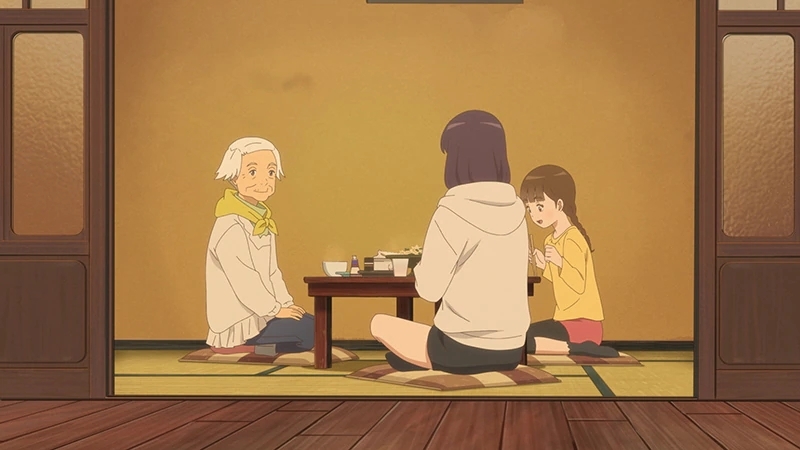
Another folk talk: a woman is visited by foxes for whom she’d cared. They bring her a knife to stab the eyes of a malevolent monster threatening her village in an act of self-sacrifice. When Kiwa herself is presented with a similar implement, she knows she must do the same. Yet unlike the woman in the folk tale, Kiwa may not be entirely alone in all this – when she takes the two girls on a trip to visit a much larger mayoiga some way away, they discover a whole, further host of supernatural creatures living in the vicinity of its premises. Along with the kappa, the most memorable of these are a pair of lion-dogs, glimpsed as a statue from which Yui removes some storm wreckage early on before we get to meet the real live creatures.

Much of this has its roots in specifically Japanese mythology or religion (see this review which unpacks it all rather well), however for those unfamiliar with such things, the sensibility here is not unlike a C.S. Lewis Narnia fantasy novel with spirit forces of goodness pitted against the bad spirit forces of the dark. Japan has embraced English children’s literature (just look at Ghibli productions like Howl’s Moving Castle, Hayao Miyazaki, 2004; Arrietty, Hiromasa Yonebayashi, 2010; When Marnie Was There, Hiromasa Yonebayashi, 2014; based on books by Diana Wynne Jones, Mary Norton [The Borrowers] and Joan G. Robinson respectively) and it may be that that sensibility has also had an influence here.

All this sits alongside more communal, Japanese themes. The non-speaking Hiyori is befriended by classmate Reiko who takes her to after school rehearsals of a fox dance ritual, a seasonal celebration which historically (in the world of the film, at least) was used to weaken the power of evil spirits or any other dark forces which might be abroad. Yui goes along too and finds herself learning to play the flute as part of the ritual. The music she learns to play is very much in the traditional Japanese vein, something that doesn’t crop up that often in anime but feels like a perfect fit here.
Other rituals include a traditional Japanese funeral following the revelation that Hiyori lost both parents in a car crash. On the little writing pad Hiyori carries around, she explains that she walked out of school “because it was like a funeral”.
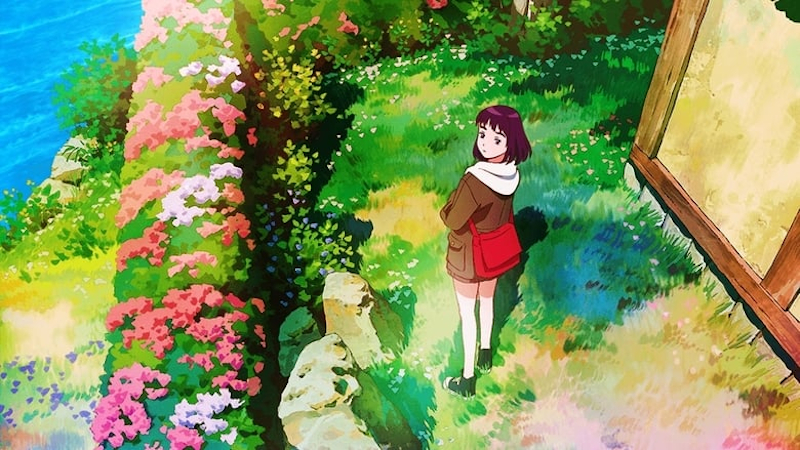
It turns out she and Yui are not sisters, as one might expect, but cousins; Yui’s very different story is that she has run away from her terrifying father. At one point, he comes looking for her – although it turns out that it’s not him at all but one of the Red Eyes snake creatures assuming his form. Or perhaps possessing him, it’s not entirely clear. (It’s a minor scene that’s passed over fairly quickly.) Elsewhere, flowers that grow out of people’s backs which the Red Eyes snakes feed on. The idea seems to indicate, as one character observes, that these creatures feed off people’s fear.
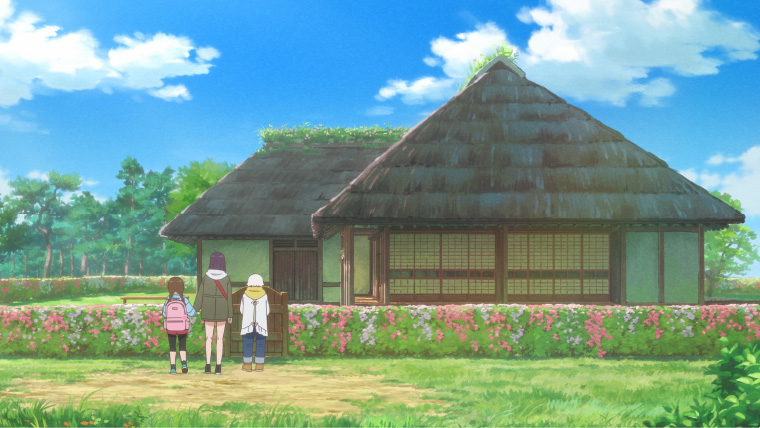
A coda after the dark forces have been successfully banished and order restored involves the planting of a cherry tree, now in full blossom, in the mayoiga’s garden, a sign of optimism for the future which leaves the audience with a warm glow at the end of the story. Although in some ways very distinctly Japanese, this is a fantastic children’s story with a much wider appeal that deserves widespread distribution.
The House Of The Lost On The Cape plays in the Annecy Animation Festival 2022 which is taking place in a 100% on-site edition this year right now in the Official Competition section.
Trailer:
Annecy 2022 trailer:
Review originally written for the Japan Foundation Touring Film Programme 2022 in UK cinemas, Friday, 4th February – Thursday, 31st March
—
2022
France – Annecy, Monday, 13th June – Saturday, 18th June
UK – Japan Foundation Touring Film Programme in UK cinemas, Friday, 4th February – Thursday, 31st March
